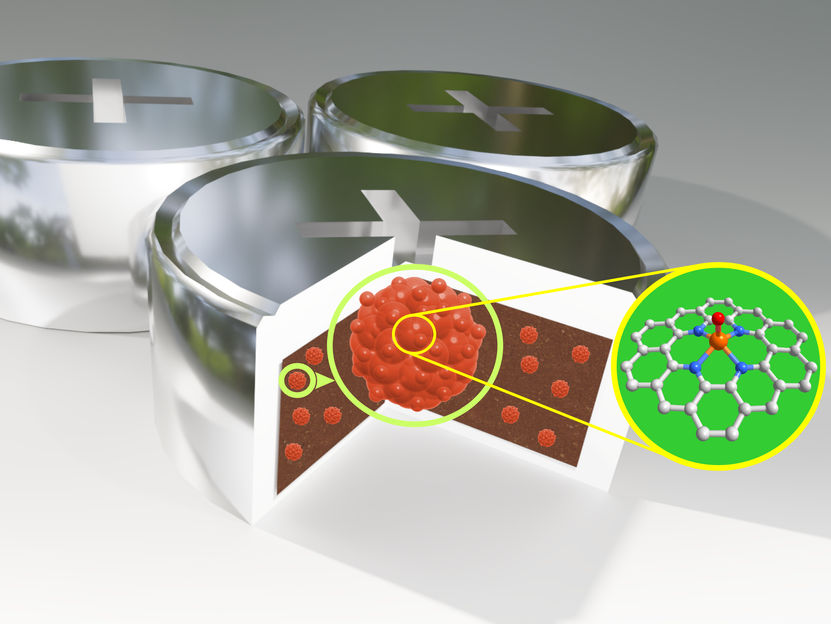Novel single-atom catalyst boosts zinc-air battery to record power density
Non-precious yet splendid
Advertisement
The long-term transformation towards renewable energies is inconceivable without modern energy storage technologies. These include batteries, in which electricity is temporarily stored in the form of chemical energy. Essential for their efficiency is the availability of suitable catalysts that allow the associated chemical reactions to proceed in an optimized manner. Scientists in Dresden have now taken a closer look at the zinc-air battery, a well-known type of battery that is nowadays mainly used as button cells, for example in hearing aids. To this end, they have developed a novel catalyst with the base metal zirconium. It can replace platinum, the precious metal most commonly applied as a catalyst to date, and still transform the battery into a powerhouse.

Going into detail: The porous catalyst (red balls) accomodates dense catalytically active zirconium sites (exemplified in the yellow circle) on its surface, thus improving the battery's chemical reactions associated to energy storage.
©Copyright: HZDR/Bernd Schröder, Minghao Yu
The new catalyst significantly improves the battery's charging and discharging performance. It is also very durable: after 130 hours of operation, the test battery still retained 92 percent of its original current. "This is an excellent value considering that we are still in the early development stages," says Dr. Agnieszka Kuc from the Institute of Resource Ecology at Helmholtz-Zentrum Dresden-Rossendorf (HZDR). She explores the chemical-physical properties of battery catalysts. These are often used in the form of metal nanostructures on suitable support materials, with their metal atoms acting as catalytically active sites. The size of the metal particles used is important for the performance of such catalysts: Experience from research shows that the catalytic effectiveness of the metal atoms generally increases the smaller the metal particles that house them are.
"The ultimate frontier is the single-atom catalyst: isolated metal atoms individually distributed on a support," explains Dr. Minghao Yu of TU Dresden. He crafts catalysts centered on single transition metal atoms – such as zirconium – trapped in a carbon matrix by neighboring carbon or nitrogen atoms lying in a plane. "In our case, however, we have also an oxygen atom as an additional coordination partner above our metal, which leads to further interaction with the electronic structure of the zirconium," Yu says, highlighting a special feature that could lead to a new design strategy for advanced single-atom catalysts.
The catalyst is designed to reduce the effects of a phenomenon that limits the practical efficiency of many electrochemical reactions: the so-called overpotential, a measure of the deviation of the real chemistry in the battery cell from what could actually be expected theoretically. "This basically means that we can harness less energy than thermodynamics predicts," Kuc explains.
Tricky miniaturization
Catalysts reduce this overpotential and thus become the key to efficiency in the conversion of chemical into electrical energy. Today, platinum-based catalysts are the benchmark in battery chemistry for commercial applications. However, they come with a disadvantage: platinum is found only in small quantities in the earth's crust and is therefore very expensive. The development of novel catalysts based on less noble metals as viable alternatives has therefore been a focus of research in recent decades. And now, the scientists from Dresden are championing a truly record-setting candidate: the base metal zirconium.
The researchers of TU Dresden, Max Planck Institute for Chemical Physics of Solids (MPI-CPfS) and HZDR had to keep an eye on one effect of miniaturization: Decreasing particle size promotes the agglomeration of those very same particles into small clusters. This in turn leads to limited performance, especially at high operating current densities. The use of a suitable carrier material that interacts strongly with the metal prevents this agglomeration and creates stable, finely distributed metal clusters with high catalytic activity. With a well-defined and uniform distribution of metal atoms, the catalysts can achieve high activity and selectivity.
"In our case, we isolated our synthesized material on the surface of quartz spheres, which have a porous structure advantageous for catalytic processes. In our arrangement, we found a pronounced aversion of zirconium to agglomeration, so we were able to produce catalysts with a high zirconium load. As a result, we have achieved a record-breaking power density among all zinc-air batteries previously made with single-atom catalysts," Kuc reports.
Original publication
Other news from the department science
Most read news
More news from our other portals
See the theme worlds for related content
Topic World Battery Technology
The topic world Battery Technology combines relevant knowledge in a unique way. Here you will find everything about suppliers and their products, webinars, white papers, catalogs and brochures.

Topic World Battery Technology
The topic world Battery Technology combines relevant knowledge in a unique way. Here you will find everything about suppliers and their products, webinars, white papers, catalogs and brochures.

































































